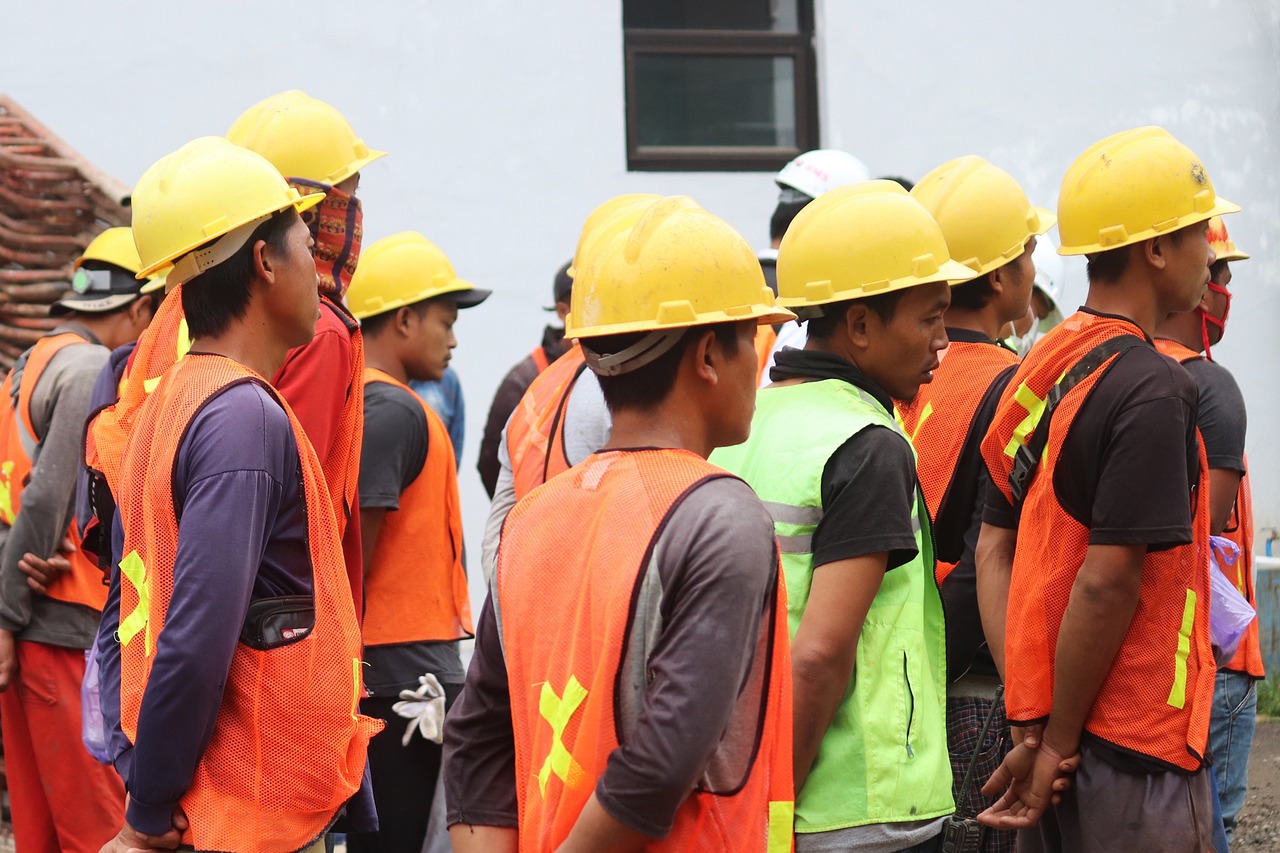Drawing Parallels between Safety Measures and Human Behavior
In our daily lives, we navigate a world filled with risks and uncertainties, making safety a paramount concern. The intricate relationship between safety measures and human behavior is not just a matter of protocols and procedures; it’s a fascinating interplay that can significantly impact how we respond to potential hazards. By understanding this connection, organizations can enhance their safety protocols, ensuring compliance and fostering a culture of safety that resonates with every individual.
Imagine a workplace where employees not only adhere to safety guidelines but actively champion them. This scenario is achievable when we delve into the psychology behind safety compliance. When safety measures are designed with an understanding of human behavior, they become more effective. For instance, consider how people often underestimate risks in their environments. By acknowledging this tendency, organizations can tailor their training programs to address these psychological biases, making safety not just a requirement but a shared value.
Moreover, the concept of behavioral economics plays a crucial role in how individuals make decisions regarding safety. People are often influenced by the way choices are presented to them. For example, if safety measures are framed positively—highlighting the benefits of compliance rather than the consequences of non-compliance—individuals are more likely to engage with them. This approach shifts the narrative from fear-based tactics to one that promotes a proactive safety culture.
Incentives are another powerful tool in shaping human behavior towards safety. They can significantly impact compliance, turning safety measures into attractive choices rather than mere obligations. Consider the following types of incentives:
- Monetary Rewards: Financial bonuses for teams that maintain excellent safety records can motivate employees to prioritize safety.
- Social Recognition: Public acknowledgment of individuals or teams who excel in safety practices fosters a sense of pride and encourages others to follow suit.
However, it’s essential to understand the difference between long-term and short-term incentives. While short-term rewards can generate immediate compliance, long-term incentives, such as career advancement opportunities linked to safety performance, can cultivate sustained behavioral changes over time. Organizations must strike a balance between these types of incentives to create a robust safety culture that endures.
Social dynamics also play a vital role in shaping safety behavior. The influence of peer pressure and group norms can either promote or hinder compliance with safety measures. In a team-oriented environment, individuals are more likely to adhere to safety protocols if their peers do. This phenomenon highlights the importance of fostering a collective responsibility towards safety. When team members support each other in following safety measures, it creates a ripple effect that enhances overall compliance.
Effective training and education programs are essential for instilling safety awareness and promoting positive behavior. These programs should not be static; instead, they must evolve to meet the changing landscape of safety challenges. For instance, integrating interactive training methods can significantly enhance engagement. Traditional lectures often fail to capture attention, but hands-on activities, simulations, and role-playing scenarios can make safety training more relatable and memorable.
Additionally, the importance of continuous learning cannot be overstated. Safety training should be an ongoing process, adapting to new risks and challenges as they arise. Regular refreshers and updates ensure that employees remain vigilant and informed about the latest safety protocols. This commitment to continuous improvement not only reinforces safety measures but also demonstrates an organization’s dedication to its employees’ well-being.
In conclusion, drawing parallels between safety measures and human behavior reveals a complex yet rewarding relationship. By understanding the psychological and social factors that influence compliance, organizations can develop more effective safety protocols. The key lies in creating a culture that values safety as a shared responsibility, where every individual feels empowered to contribute to a safer environment.
- Why is understanding human behavior important for safety measures?
Understanding human behavior helps organizations design safety measures that resonate with individuals, leading to better compliance and a stronger safety culture. - What role do incentives play in promoting safety compliance?
Incentives, both monetary and social, can motivate individuals to adhere to safety protocols by making compliance rewarding and recognized. - How can training programs improve safety behavior?
Interactive and ongoing training programs engage employees more effectively, ensuring they retain safety knowledge and apply it in their daily routines.

The Psychology of Safety Compliance
When it comes to safety compliance, the psychological factors at play are as intricate as a web spun by a skilled spider. Understanding these factors can be the key to unlocking better safety practices within any organization. Why do people sometimes ignore safety protocols? Is it a lack of awareness, or is it something deeper? The answer often lies in the way our brains are wired to respond to risks and rewards.
Humans are inherently influenced by their environment, and this extends to how they perceive safety measures. For example, if an employee witnesses a colleague bypassing a safety protocol without immediate consequences, they may subconsciously adopt a similar mindset. This is where the concept of social proof comes into play. People tend to follow the actions of others, especially in a group setting, which can either promote or undermine safety compliance.
Moreover, the fear of negative consequences can be a double-edged sword. While it might motivate some individuals to adhere to safety protocols, it can also lead others to become complacent, thinking, "It won’t happen to me." This mindset can create a false sense of security, making it crucial for organizations to foster a culture of safety that emphasizes proactive behavior rather than merely reacting to incidents.
To tackle these psychological barriers, organizations can implement several strategies:
- Awareness Campaigns: Regularly educate employees about the importance of safety protocols and the potential consequences of non-compliance.
- Positive Reinforcement: Recognize and reward safe behaviors to create a culture where compliance is valued.
- Peer Involvement: Encourage employees to hold each other accountable, fostering a community where safety is a shared responsibility.
In summary, understanding the psychology of safety compliance is not just about implementing rules; it’s about understanding the human experience. By addressing the psychological factors that influence behavior, organizations can create a more effective safety culture that encourages compliance and minimizes risks. After all, when employees feel valued and understood, they are more likely to embrace safety measures as part of their daily routines.

Behavioral Economics in Safety Practices
When we think about safety practices, it’s easy to overlook the fascinating world of behavioral economics. This field studies how psychological factors influence our decision-making processes, especially when it comes to safety. Have you ever wondered why some people seem to ignore safety protocols, even when they know the risks? That’s where behavioral economics steps in, shedding light on the irrational behaviors that often dictate our choices. Understanding these behaviors can help organizations design safety measures that resonate better with individuals, making compliance not just a requirement but a natural inclination.
One of the key principles of behavioral economics is the concept of loss aversion. This principle suggests that people are more motivated to avoid losses than to achieve gains. For instance, if an employee is informed that failing to wear proper safety gear could lead to a hefty fine, they may be more likely to comply than if they were simply told about the benefits of wearing the gear. This highlights the importance of framing safety messages in a way that emphasizes potential losses rather than just benefits. By doing so, organizations can tap into the natural human instinct to avoid negative outcomes.
Another fascinating aspect is the idea of nudges. Nudges are subtle changes in the environment that can significantly alter behavior without restricting choices. Imagine a workplace where safety gear is placed at the entrance, making it the first thing employees see as they arrive. This small change can act as a nudge, reminding them to put on their gear before starting work. Similarly, using visual cues, such as signs or color-coded systems, can guide employees towards safer practices effortlessly. The goal here is to create an environment where safe choices are the easiest choices.
Moreover, social proof plays a vital role in decision-making. People tend to look to others for guidance on how to behave, especially in uncertain situations. If employees observe their peers consistently adhering to safety measures, they are more likely to follow suit. This phenomenon can be leveraged by showcasing safety champions within the organization—individuals who exemplify adherence to safety protocols. By highlighting these role models, organizations can foster a culture of safety that encourages everyone to participate actively.
To further illustrate these concepts, consider the following table that summarizes key behavioral economics principles and their application in safety practices:
| Behavioral Economics Principle | Description | Application in Safety Practices |
|---|---|---|
| Loss Aversion | People prefer to avoid losses over acquiring equivalent gains. | Highlight potential penalties for non-compliance. |
| Nudges | Subtle changes that influence behavior without restricting choices. | Position safety gear prominently at entry points. |
| Social Proof | People are influenced by the behavior of others. | Promote safety champions to encourage compliance. |
In conclusion, integrating behavioral economics into safety practices can revolutionize how organizations approach compliance. By understanding the psychological triggers that drive behavior, companies can create environments that not only promote safety but also make it a fundamental part of their culture. So, the next time you think about safety measures, remember that it’s not just about rules; it’s about understanding the human mind and crafting strategies that resonate with it.
- What is behavioral economics? Behavioral economics studies the effects of psychological, cognitive, emotional, cultural, and social factors on economic decisions.
- How can loss aversion be applied to safety practices? By emphasizing the potential losses associated with unsafe behaviors, organizations can motivate individuals to comply with safety protocols.
- What are nudges in the context of safety? Nudges are subtle environmental changes that encourage safer behaviors without limiting choices, such as placing safety gear at the entrance.
- Why is social proof important for safety compliance? Social proof influences individuals to conform to the behaviors of their peers, fostering a culture of safety within the organization.

The Role of Incentives
Incentives play a crucial role in shaping human behavior, particularly when it comes to adhering to safety measures. Think of incentives as the fuel that drives the engine of compliance; without them, even the best safety protocols can stall. When people perceive a benefit—be it financial, social, or personal—they are more likely to engage in behaviors that align with safety standards. This connection is not just theoretical; it’s backed by a wealth of research in psychology and behavioral economics that shows how motivation can significantly alter actions.
To illustrate, consider a workplace where safety compliance is mandatory. If employees know that following safety protocols could lead to a monetary bonus or public recognition, they are more likely to take the necessary precautions. This is where the concept of incentives comes into play, acting as a push factor that enhances compliance. Organizations can utilize various types of incentives to encourage safer behaviors, such as:
- Monetary Rewards: Cash bonuses or gift cards for teams that maintain a perfect safety record.
- Social Recognition: Highlighting individuals or teams in company newsletters or meetings for their commitment to safety.
- Professional Development: Offering training sessions or certifications for those who consistently adhere to safety protocols.
However, it’s essential to understand that not all incentives are created equal. The effectiveness of an incentive can vary depending on its nature and timing. For instance, immediate rewards may be more effective in reinforcing behavior than delayed ones, much like how a child learns to associate good behavior with a treat. This brings us to the distinction between short-term and long-term incentives, both of which have their place in promoting safety compliance.
Short-term incentives, such as a monthly safety bonus, can create a quick spike in compliance. However, they might not foster lasting behavioral change. On the other hand, long-term incentives, like career advancement opportunities tied to safety performance, can lead to a more profound and sustained commitment to safety practices. The challenge lies in finding the right mix of both types of incentives that resonate with the workforce.
In conclusion, understanding the role of incentives in safety compliance is not just about offering rewards; it's about creating a culture where safety is valued and recognized. By aligning incentives with safety goals, organizations can foster an environment where employees feel motivated to prioritize safety, ultimately leading to a safer workplace for everyone.
- What types of incentives are most effective for promoting safety?
Both monetary rewards and social recognition have proven effective, but the best approach often combines elements of both.
- How can organizations measure the effectiveness of their incentive programs?
Organizations can track safety compliance rates before and after implementing incentive programs to gauge their impact.
- Are short-term incentives sustainable in the long run?
While they can boost immediate compliance, relying solely on short-term incentives may not lead to lasting behavioral change.

Types of Incentives
When it comes to promoting safety compliance, understanding the that can motivate individuals is crucial. Incentives can be broadly categorized into two main types: monetary rewards and non-monetary rewards. Each type has its unique way of influencing behavior and can be tailored to fit the culture and dynamics of an organization.
Monetary rewards, as the name suggests, involve financial compensation. This could be in the form of bonuses, gift cards, or even raises for employees who consistently follow safety protocols. The appeal of cash is universal; after all, who wouldn’t want a little extra dough? However, while monetary incentives can yield quick results, they might not always create lasting change. Think of it like a sugar rush—great in the moment but fading fast!
On the other hand, non-monetary rewards can be just as effective, if not more so, in fostering a culture of safety. These can include:
- Social Recognition: Public acknowledgment of an individual's commitment to safety can go a long way. Whether it’s a shout-out at a team meeting or a spot on the company’s safety wall of fame, people love to feel appreciated.
- Professional Development Opportunities: Offering training sessions, workshops, or certifications as rewards can motivate employees to take safety seriously. Not only do they feel valued, but they also gain skills that can enhance their careers.
- Team-Based Incentives: Sometimes, creating a collective goal can foster camaraderie among employees. For instance, if the entire team adheres to safety practices for a month, they could receive a team outing or a celebratory lunch.
But here’s the catch: the effectiveness of these incentives often hinges on how they are implemented. It’s essential for organizations to communicate the importance of safety and the rationale behind the incentives clearly. If employees understand that these rewards are not just handouts but are tied to their safety and well-being, they are more likely to engage with the program wholeheartedly.
Moreover, it's vital to consider the individual differences among employees. What might motivate one person may not resonate with another. For instance, while some may thrive on public recognition, others might prefer a more private acknowledgment of their efforts. Hence, a one-size-fits-all approach to incentives can be counterproductive. Tailoring incentives to meet the diverse needs and preferences of employees can lead to a more engaged workforce and ultimately foster a safer environment.
In conclusion, both monetary and non-monetary incentives play a significant role in shaping safety behavior. Organizations that recognize and implement a mix of these incentives, while also considering individual preferences, are likely to see improved compliance and a stronger safety culture. After all, when employees feel valued and motivated, they are more likely to prioritize safety in their daily routines.
Q: What are the most effective types of incentives for promoting safety?
A: Both monetary and non-monetary incentives can be effective. The best approach is often a combination of both, tailored to the preferences of the workforce.
Q: How can organizations ensure that their incentive programs are successful?
A: Clear communication about the importance of safety, along with regular feedback and adjustment of the incentive programs based on employee input, can enhance their effectiveness.
Q: Can incentives lead to complacency in safety practices?
A: If not managed properly, incentives can lead to complacency. It's essential to continuously engage employees and keep safety at the forefront of their minds, rather than relying solely on rewards.

Long-term vs. Short-term Incentives
When it comes to motivating individuals to adhere to safety measures, understanding the distinction between long-term and short-term incentives is crucial. Think of it like planting a seed versus picking a ripe fruit; both have their place, but the outcomes and timelines differ significantly. Short-term incentives often provide immediate rewards, such as a bonus or a gift card, which can quickly boost compliance and enthusiasm for safety practices. However, these rewards might only lead to temporary changes in behavior. For instance, an employee may wear safety gear diligently for a week following a monetary reward but revert to old habits once the incentive is removed.
On the other hand, long-term incentives focus on sustained commitment to safety practices. These might include ongoing recognition programs, career advancement opportunities linked to safety performance, or even safety-related training that enhances an employee's skill set over time. Such incentives not only encourage compliance but also foster a culture of safety that becomes ingrained in the organization’s ethos. The challenge, however, lies in ensuring that these long-term incentives remain appealing and relevant to the workforce.
To illustrate the effectiveness of both types of incentives, consider the following table:
| Type of Incentive | Duration | Impact on Behavior | Examples |
|---|---|---|---|
| Short-term Incentives | Immediate | Quick compliance, temporary change | Bonuses, gift cards, free lunches |
| Long-term Incentives | Ongoing | Sustained commitment, cultural integration | Recognition programs, career advancement, safety training |
In practice, a balanced approach that incorporates both types of incentives can yield the best results. Organizations can use short-term incentives to create an initial buzz around safety practices, while simultaneously investing in long-term strategies that build a robust safety culture. This dual approach not only addresses the immediate need for compliance but also nurtures a deeper understanding and appreciation of safety protocols among employees.
Ultimately, the choice between long-term and short-term incentives should be guided by the specific goals of the organization and the unique characteristics of its workforce. By carefully considering how these incentives align with employee motivations, companies can craft safety programs that not only encourage compliance but also promote a lasting commitment to safe practices.
- What are examples of short-term incentives for safety compliance? Short-term incentives can include bonuses, gift cards, or recognition during team meetings.
- How can organizations implement long-term incentives? Organizations can implement long-term incentives through career development programs, ongoing safety training, and recognition for consistent safety practices.
- Why is it important to balance short-term and long-term incentives? Balancing both types of incentives helps maintain immediate compliance while fostering a culture of safety that promotes sustainable behavior change.

Social Influences on Safety Behavior
When we think about safety in the workplace or any environment, it’s easy to focus solely on the rules and regulations that guide our actions. However, the truth is that social influences play a monumental role in shaping how we behave when it comes to safety. Imagine a group of people, all gathered together, and one person decides to take a shortcut that compromises safety. What happens next? More often than not, others may follow suit, influenced by that individual’s actions. This phenomenon highlights the power of peer pressure and group dynamics in determining safety behavior.
Research shows that human beings are inherently social creatures. We tend to look to our peers for cues on how to behave, especially in uncertain situations. This is where the concept of group norms comes into play. If a workplace has a culture that prioritizes safety, employees are more likely to adhere to safety protocols. Conversely, if they witness colleagues bypassing safety measures without repercussions, they may feel justified in doing the same. This can create a ripple effect that undermines the very safety measures designed to protect them.
To illustrate this, consider the following table that summarizes how different social factors can influence safety behavior:
| Social Factor | Influence on Safety Behavior |
|---|---|
| Peer Pressure | Can lead to either positive or negative safety behaviors based on the actions of others. |
| Group Norms | Establishes a standard of behavior that individuals feel compelled to follow. |
| Leadership Example | Leaders who prioritize safety set a tone that encourages compliance among team members. |
| Social Recognition | Public acknowledgment of safe behavior can motivate others to follow suit. |
Additionally, the role of leadership cannot be overstated. Leaders who actively demonstrate safe practices and prioritize safety in their decision-making create an environment where employees feel empowered to do the same. This is not just about enforcing rules; it’s about cultivating a culture where safety is a shared value. When everyone, from the top down, is committed to safety, it creates a powerful social influence that encourages compliance.
Moreover, social recognition can serve as a significant motivator. When individuals receive praise or acknowledgment for adhering to safety protocols, it reinforces their behavior and encourages others to follow suit. This creates a positive feedback loop where safe behavior is celebrated, making it more likely to be repeated. Imagine a workplace where safety achievements are highlighted in meetings or through internal communications—this not only boosts morale but also fosters a collective commitment to safety.
In conclusion, the interplay between social influences and safety behavior is complex yet crucial. By understanding how peer pressure, group norms, leadership, and social recognition shape our actions, organizations can implement strategies that leverage these dynamics to enhance safety compliance. After all, safety is not just about rules; it’s about creating a culture where everyone feels responsible for each other’s well-being.
- How can peer pressure affect safety compliance? Peer pressure can lead individuals to either follow safe practices or take unnecessary risks based on the behavior of those around them.
- What role does leadership play in safety behavior? Leaders set the tone for safety culture; their commitment to safety can inspire employees to prioritize it as well.
- How can social recognition improve safety practices? Acknowledging safe behavior publicly can motivate others to adopt similar practices, creating a positive safety culture.

Training and Education's Impact on Behavior
When it comes to safety in any environment, whether it’s a bustling construction site or a quiet office, the importance of training and education cannot be overstated. These elements serve as the backbone of effective safety protocols, shaping how individuals perceive and respond to potential hazards. Imagine a world where every employee is not just aware of safety measures but is actively engaged in practicing them. This is the transformative power of well-structured training programs. They not only inform but also inspire a culture of safety that permeates throughout the organization.
One of the most effective ways to instill safety awareness is through interactive training methods. Traditional lectures can often feel monotonous, leading to disengagement and a lack of retention of critical information. In contrast, interactive training engages participants in a way that makes learning both fun and memorable. Techniques such as role-playing, simulations, and hands-on activities can significantly enhance the learning experience. For example, a safety drill that allows employees to practice emergency procedures in real-time can be far more effective than simply reading about them in a manual. This type of engagement not only boosts retention but also builds confidence among employees, empowering them to act decisively in real-life situations.
Moreover, the concept of continuous learning is crucial in the realm of safety training. The workplace is not static; it evolves with new technologies, processes, and regulations. Therefore, safety training should be an ongoing process rather than a one-time event. Regular refresher courses and updates about new safety protocols ensure that employees are always informed and prepared. This adaptability is key in fostering a safety-oriented mindset. When employees recognize that safety is a living, breathing aspect of their work life, they are more likely to internalize these practices and make them a part of their daily routines.
To illustrate the impact of training and education on behavior, consider the following table that outlines the differences in outcomes between traditional training methods and interactive, continuous learning approaches:
| Aspect | Traditional Training | Interactive & Continuous Training |
|---|---|---|
| Engagement Level | Low | High |
| Retention of Information | Limited | Enhanced |
| Confidence in Applying Knowledge | Moderate | High |
| Adaptability to New Protocols | Slow | Rapid |
In conclusion, the impact of training and education on safety behavior is profound. By embracing interactive methods and fostering a culture of continuous learning, organizations can cultivate a workforce that is not only knowledgeable about safety protocols but also committed to implementing them. This shift in mindset is essential for reducing incidents and promoting a safer work environment for everyone.
- Why is interactive training more effective than traditional methods?
Interactive training engages participants actively, leading to better retention and understanding of safety protocols. - How often should safety training be conducted?
Safety training should be continuous, with regular refresher courses to keep employees updated on new practices and protocols. - What role does continuous learning play in workplace safety?
Continuous learning ensures that employees are adaptable and prepared for evolving safety challenges, fostering a proactive safety culture.

Interactive Training Methods
When it comes to safety training, the old-fashioned lecture style just doesn’t cut it anymore. Imagine sitting in a room for hours, listening to someone drone on about safety protocols. Yawn, right? Interactive training methods are the breath of fresh air that can transform the way we approach safety education. These methods not only keep participants engaged but also significantly enhance their understanding and retention of crucial safety information.
So, what exactly are interactive training methods? They include a variety of techniques that actively involve participants in the learning process. Think of it like a hands-on workshop versus a textbook reading session. For instance, role-playing scenarios allow individuals to practice safety measures in a controlled environment. This not only boosts confidence but also prepares them for real-life situations where quick decision-making is critical.
Another effective method is the use of simulations. Imagine a fire drill where employees can experience the urgency of evacuating a building under pressure. This kind of immersive experience is invaluable. It helps participants understand the importance of following safety protocols and the potential consequences of neglecting them. Plus, it’s a lot more memorable than just reading about it!
Incorporating technology can also elevate interactive training. Virtual reality (VR) and augmented reality (AR) are becoming game-changers in safety training. These technologies allow participants to engage in realistic scenarios without the risks associated with real-life training. For example, a VR simulation can place employees in hazardous situations, teaching them how to react appropriately while ensuring their safety. It’s like playing a video game, but instead of just having fun, you’re learning to save lives!
To ensure the effectiveness of these interactive methods, it’s essential to gather feedback from participants. After all, who better to evaluate the training than those who went through it? Surveys and discussions can provide insights into what worked and what didn’t, allowing organizations to continuously improve their training programs.
In summary, interactive training methods break the mold of traditional safety education. They foster engagement, enhance retention, and ultimately lead to safer workplaces. By investing in these innovative approaches, organizations not only comply with safety regulations but also cultivate a culture of safety that resonates with every employee.
- What are interactive training methods? Interactive training methods are techniques that involve participants actively in the learning process, such as role-playing, simulations, and the use of technology like VR and AR.
- Why are interactive methods more effective than traditional training? They engage participants more, making the learning experience memorable and applicable to real-life situations, which enhances understanding and retention of safety protocols.
- How can organizations implement interactive training? Organizations can implement these methods by incorporating hands-on activities, using technology, and soliciting feedback from participants to refine their training programs.

Continuous Learning and Adaptation
In today’s rapidly evolving world, the concept of continuous learning and adaptation has become more crucial than ever, especially in the context of safety. Just as a river carves its path through the landscape, safety protocols must be flexible enough to navigate the changing terrain of workplace hazards and regulations. Organizations that embrace this philosophy not only enhance their safety measures but also foster a culture where employees feel empowered to contribute to their own safety and that of their colleagues.
Imagine a workplace where every employee is not just a passive participant in safety training but an active contributor to its evolution. This is where continuous learning comes into play. It’s not merely about attending a seminar once a year; it’s about creating an environment where safety is a dynamic conversation. Regular workshops, feedback sessions, and open forums can serve as platforms for employees to share their experiences and suggest improvements. This fosters a sense of ownership and responsibility, making safety a shared goal rather than a mandated task.
Furthermore, the integration of technology can significantly enhance continuous learning. For instance, utilizing mobile apps and online platforms can provide employees with easy access to safety resources and training materials at their fingertips. These tools can be updated in real-time, ensuring that everyone is informed about the latest safety protocols and best practices. This approach not only keeps safety fresh in everyone’s minds but also accommodates different learning styles, making it easier for all employees to engage with the material.
Adaptation is equally important in the safety landscape. As new technologies emerge and work environments change, safety measures must evolve accordingly. For example, the rise of remote work due to recent global events has necessitated a rethink of safety protocols. Organizations must adapt their training programs to address the unique challenges posed by remote work, such as ergonomic safety and cybersecurity. This means that safety training should not be static; it should be a living, breathing entity that evolves alongside the workforce.
To highlight the significance of continuous learning and adaptation in safety practices, consider the following table that outlines key components:
| Component | Description |
|---|---|
| Regular Training Sessions | Frequent workshops and training sessions to keep safety information current. |
| Feedback Mechanisms | Systems for employees to provide input on safety practices and suggest improvements. |
| Technology Integration | Utilizing apps and online platforms for easy access to safety resources. |
| Adaptation to Change | Updating safety protocols in response to new technologies and work environments. |
In summary, the journey towards a safer workplace is not a one-time event; it’s an ongoing process that requires commitment from both management and employees. By fostering a culture of continuous learning and adaptation, organizations can ensure that safety remains a top priority, capable of evolving to meet new challenges. Just as the most resilient trees bend with the wind, so too must safety measures be flexible and responsive to the environment they exist in. This adaptability not only enhances compliance but also cultivates a workplace where safety is seen as a shared responsibility, ultimately leading to a safer and more productive environment for all.
- Why is continuous learning important in safety practices?
Continuous learning helps keep safety protocols relevant and effective, adapting to new challenges and technologies. - How can organizations encourage a culture of safety?
By fostering open communication, providing regular training, and involving employees in safety discussions. - What role does technology play in safety training?
Technology provides accessible resources for training and can facilitate real-time updates to safety protocols. - How can feedback improve safety measures?
Feedback allows organizations to identify gaps in safety practices and make necessary adjustments based on employee experiences.
Frequently Asked Questions
- What are the key psychological factors influencing safety compliance?
Understanding psychological factors such as risk perception, motivation, and social influences is crucial for enhancing safety compliance. When organizations recognize how these elements affect behavior, they can tailor safety measures to align with human tendencies, making compliance more likely.
- How does behavioral economics apply to safety practices?
Behavioral economics sheds light on the decision-making processes individuals go through regarding safety. By understanding how people weigh risks and rewards, organizations can implement strategies that nudge individuals toward safer choices, ultimately leading to a more secure environment.
- What types of incentives can improve safety behavior?
Incentives can range from monetary rewards to social recognition. Both types can effectively motivate individuals to adhere to safety measures. However, the key is to find the right balance that encourages ongoing compliance without fostering a culture of complacency.
- What’s the difference between long-term and short-term incentives?
Short-term incentives may provide immediate gratification, encouraging quick compliance, while long-term incentives focus on sustained behavior change over time. Understanding this distinction helps organizations design incentive programs that foster a deeper commitment to safety practices.
- How do social influences affect safety behavior?
Social dynamics, such as peer pressure and group norms, significantly impact safety behavior. When safety is prioritized within a group, individuals are more likely to comply with safety protocols. Conversely, negative influences can lead to risky behaviors, highlighting the importance of fostering a supportive safety culture.
- Why is training and education vital for safety compliance?
Effective training and education programs empower individuals with the knowledge and skills needed to recognize hazards and respond appropriately. By instilling safety awareness, organizations can promote positive behavior and create a safer work environment.
- What are some effective interactive training methods?
Interactive training methods, such as simulations, role-playing, and group discussions, engage participants more effectively than traditional lectures. These techniques enhance learning retention and make safety training more enjoyable, leading to better compliance in real-world situations.
- How important is continuous learning in safety training?
Continuous learning is essential for adapting to evolving safety challenges. Regular training updates and refreshers ensure that employees stay informed about the latest safety protocols and best practices, fostering a culture of safety that evolves with the workplace.



















